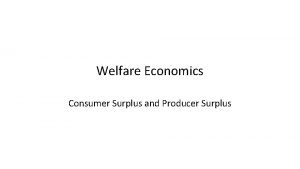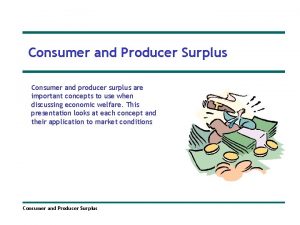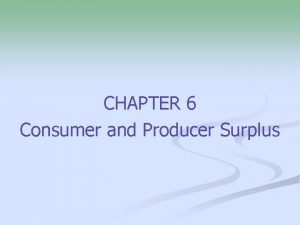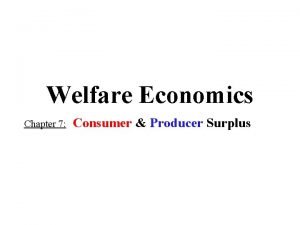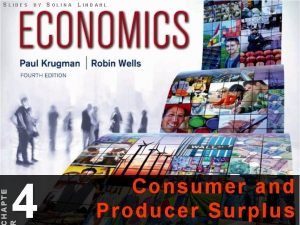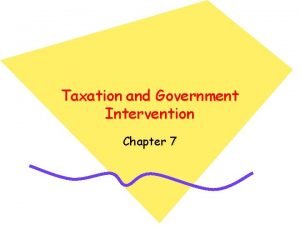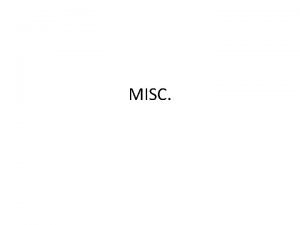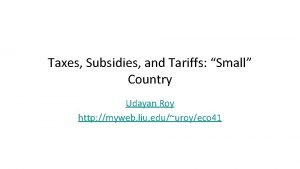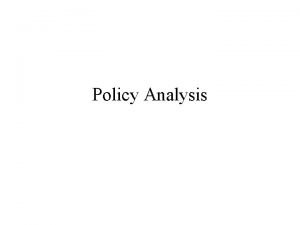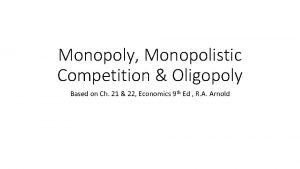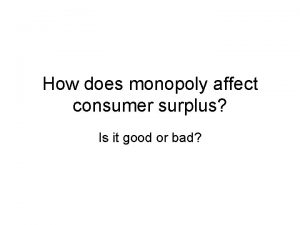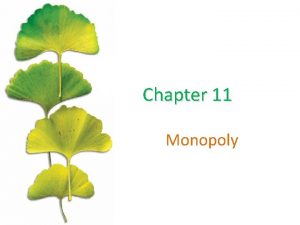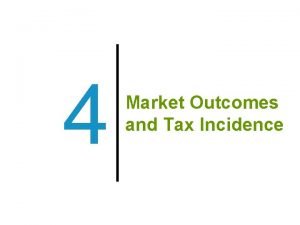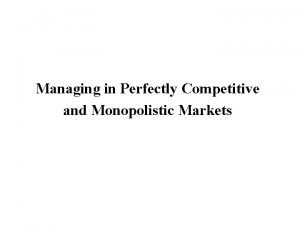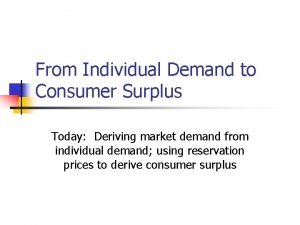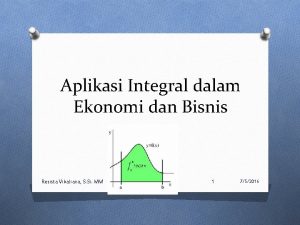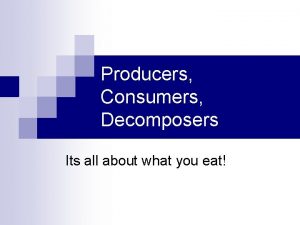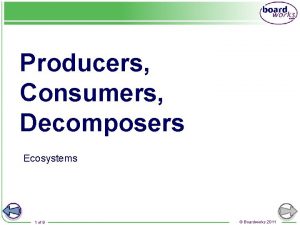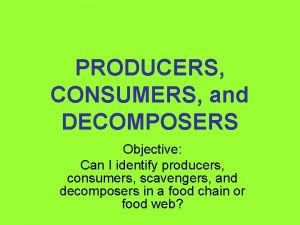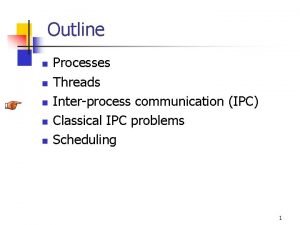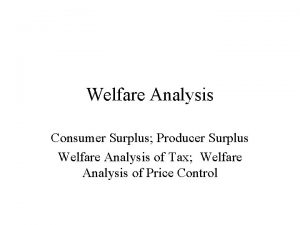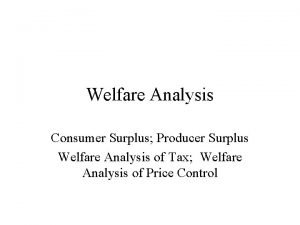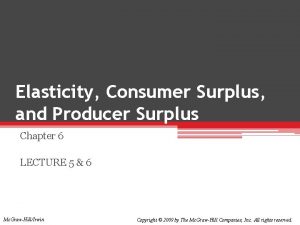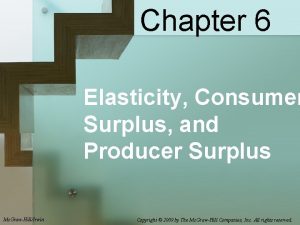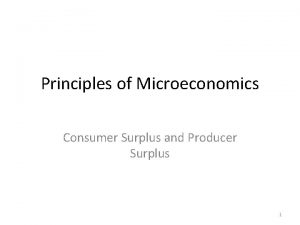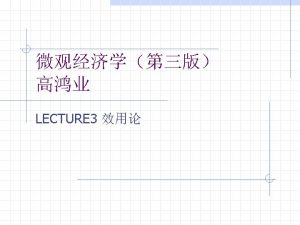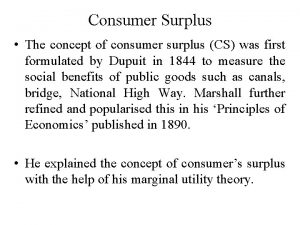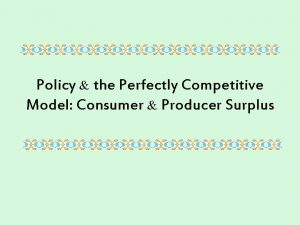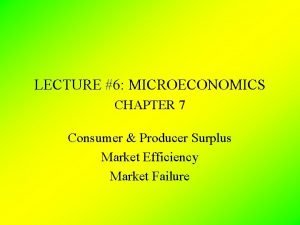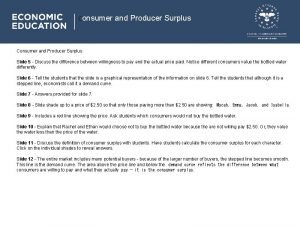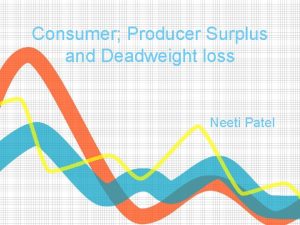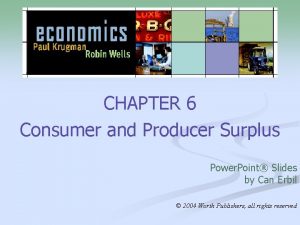Policy Analysis Outline Welfare Analysis Consumer surplus Producer


























- Slides: 26

Policy Analysis

Outline • Welfare Analysis – Consumer surplus – Producer surplus • Welfare consequences of minimum wage • Wage subsidy as alternative to minimum wage • Tortillas as a Cautionary Tale

Economic Efficiency • A situation is economically inefficient if there is some way to change it so that someone gains while no one else loses. • A change is a Pareto improvement if at least one person gains and no one loses • A change is economically efficient if the winners could compensate the losers by enough to make the change a Pareto improvement.

Assessing Benefits • • • Consumer Sovereignty “Willingness to Pay” = Consumer Benefit Consumer Surplus “Willingness to Sell” =Opportunity Cost Producer Surplus

Consumer Surplus -- Difference between Willingness to Pay and Price Paid by Buyer Price r 1 r 2 r 3 r 4 P 0 Demand 1 2 3 4 5 Quantity

Consumer Surplus Is Triangle Below Demand, Above Market Price Consumer Surplus P 0 Demand 5 Quantity Total Expenditure

Producer Surplus- Difference Between Opportunity Cost and Selling Price t 5 t 4 t 3 t 2 t 1 P 0=t 5 1 2 3 4 5 Quantity

Producer Surplus Price Supply P 0=t 5 Producer Surplus Quantity

Consumer and Producer Surplus - Market Equilibrium Price Consumer Surplus Supply P 0 Producer Surplus Q 0 Demand Quantity

Impact of Price Floor on Efficiency A -- New CS A+B+E -- Old CS B+C+D -- New PS C+F+D -- Old PS Supply A Price Floor B E F C Market clearing price D Demand Q 1 Q 0 E+F is deadweight loss associated with the price floor.

Impact of Price Ceiling on Efficiency Demand A+B+C -- New CS A+B+E -- Old CS D -- New PS C+D+F -- Old PS Supply A B C D E F Market Clearing Price Ceiling E+F is the Deadweight Loss Associated with Price Ceiling

SUMMARY • Market Equilibrium is Efficient. No Deadweight Loss. • Price controls create a deadweight loss • Also, there are costs associated with rationing mechanisms, black markets etc.

Impact of $12 Minimum Wage

$2 Wage Subsidy

Comparison • If demand is elastic, minimum wage reduces employment • Benefits accrue to workers who stay employed • Costs borne by employers and consumers • Wage subsidy increases employment • Benefits shared by employers and workers • Subsidy funded from general government revenues

Subsidy Benefits Employers and Workers

Impact of Subsidy on Efficiency Price Sellers receive A+B+F+E = CS after Subsidy A+B = CS before Subsidy B+C+F+G = PS after Subsidy F+G= PS before Subsidy B+C+D+E+F = Subsidy D=Deadweight Loss from Subsidy A B Price buyers pay F C E Pre Subsidy Price D G Pre Subsidy Q Post Subsidy Q

Tortillas On New Year’s Day 1999, Mexico ended price controls on tortillas. The price stood at 3 pesos per kilo (31 cents for 2. 2 pound stack). Some shops immediately raised their prices by 50%. In 1998, the government phased out subsidies to the tortilla industry that helped keep prices down. The tortilla subsidy was replaced with programs such as one that gives the 1. 2 million poorest Mexicans free tortillas each day. Source: Smith, James, Los Angeles Times, Jan 7, 1999

Questions • What does the price increase suggest about the elasticity of demand for tortillas? • How does the impact of a subsidy to consumers differ from the impact of a subsidy to producers? • What are the advantages of price controls as compared with subsidies?

P Elasticity of Demand for Tortillas? Supply PA Price ceiling PB Demand A Kilos of tortillas

Subsidy to Producers

Subsidy to Consumers

Another Approach

If All Consumers Received Subsidy: • If all consumers receive the subsidy, output is same • Price producers receive is same in two cases • Price consumers pay is same in two cases

Disadvantages of Subsidies • Control of subsidies by local bureaucrats created opportunties to exploit subsidies for political ends. Price controls anonymous. • Consumers not eligible for subsidies, but still relatively poor will pay a higher price for tortillas.

Key Concepts • Impact of price controls and of subsidies depends on elasticity of demand (and supply). • Price floors lead to surpluses. Price ceilings to shortages. • Price controls lead to a deadweight loss.
 Producer surplus
Producer surplus Consumer surplus and producer surplus
Consumer surplus and producer surplus Consumer and producer surplus
Consumer and producer surplus Producer surplus formula
Producer surplus formula When are consumer and producer surplus maximized?
When are consumer and producer surplus maximized? Food web diagram
Food web diagram Producer surplus
Producer surplus Taxation and government intervention
Taxation and government intervention Producer surplus formula
Producer surplus formula Import quota
Import quota Government tariffs
Government tariffs Consumer surplus with subsidy
Consumer surplus with subsidy Consumer surplus in monopolistic competition
Consumer surplus in monopolistic competition Consumer surplus in a monopoly
Consumer surplus in a monopoly Consumer surplus in monopolistic competition
Consumer surplus in monopolistic competition Perfectly discriminating monopolist
Perfectly discriminating monopolist Consumer surplus in a monopoly
Consumer surplus in a monopoly Consumer surplus inelastic demand
Consumer surplus inelastic demand Tr
Tr 1. individual demand and consumer surplus
1. individual demand and consumer surplus Contoh soal consumer surplus
Contoh soal consumer surplus Producer consumer decomposer activity
Producer consumer decomposer activity Producer consumer decomposer
Producer consumer decomposer Producers and decomposers
Producers and decomposers Is a horse a producer consumer or decomposer
Is a horse a producer consumer or decomposer Decomposers examples
Decomposers examples Producer-consumer problem
Producer-consumer problem
